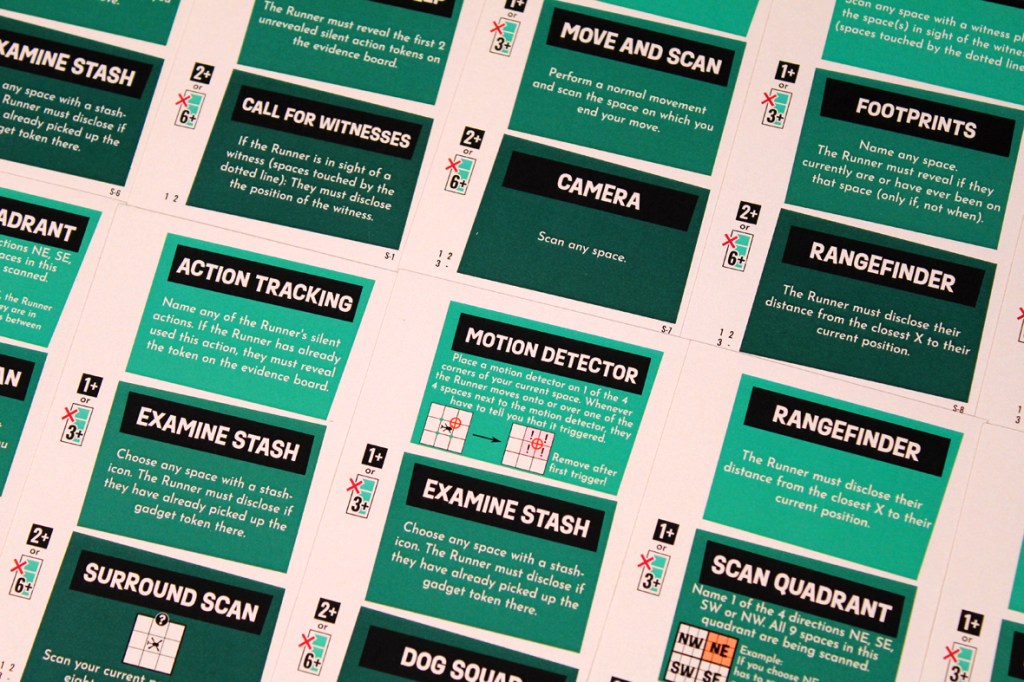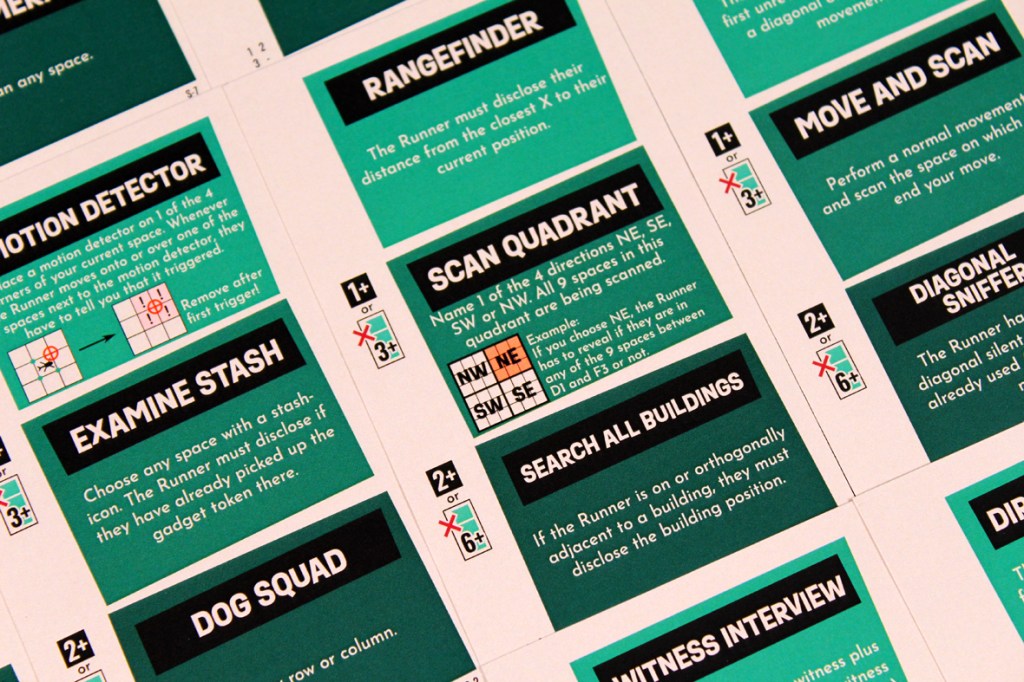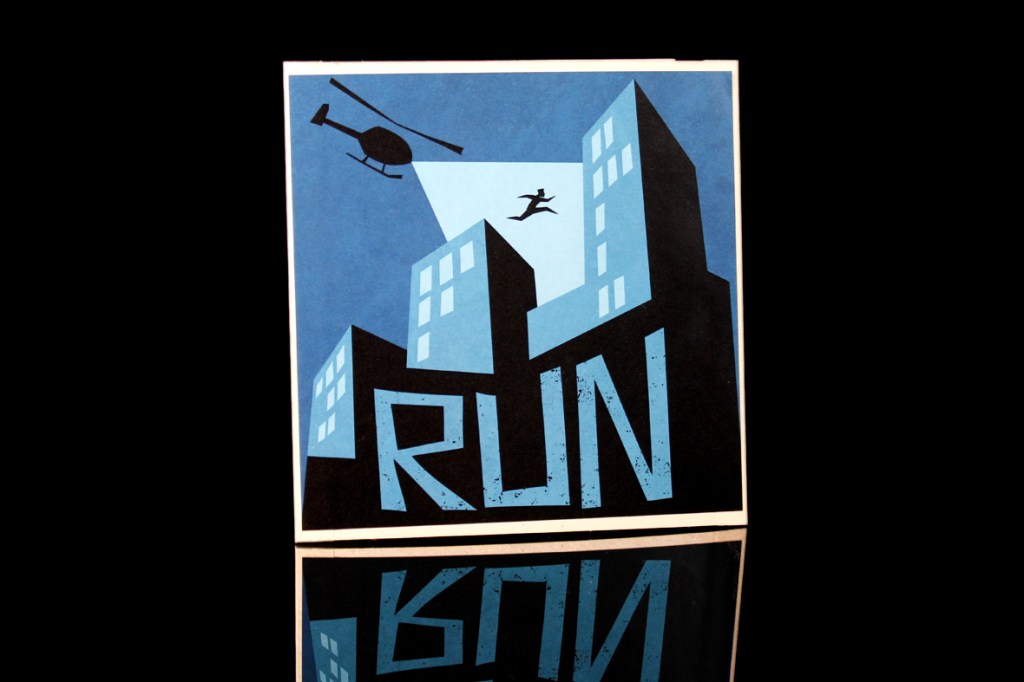
2 players.
Play time: 10 – 30 minutes.
BGG Link
Check it out on Backerkit!
Logged plays: 2
Full disclosure: A preview copy of Run was provided by Fowers Games. Some art, gameplay, or other aspects of the game may change between this preview and the fulfillment of the crowdfunding campaign, should it fund, as this is a preview of a currently unreleased game.
Got a few crowdfunding games coming through! One this week, Rise & Fall next week, and another Kickstarter game in October. Honestly, it helps me keep track of time. I’m writing this a bit closer than I’d like to the deadline, but Gen Con has a way of throwing a wrench in my planning gears essentially constantly. My reward is the Star Trek: Lower Decks Season 3 Premiere, so, excited for that. In deference to that dropping in nine minutes, I’m going to dive right in and tell you more about Run!
In Run, you’ve got a chase on your hands! One player takes on the role of Dispatch, sent to catch the other player, the Runner, before they can collect various Gadgets from their Stashes about town and make it to a Safe House. The Runner is trying to move silently and quickly, but Dispatch has a lot of tools, a lot of backup, and a very large helicopter, so that’s going to be quite the challenge. But Dispatch isn’t the only one with fancy Gadgets. The chase is on across the nighttime city streets; will you be able to avoid capture or will you get your prey?
Contents
Setup
First, decide which player should be the Dispatcher and which player should be the Runner. Then, each player should set a map tray in front of them:
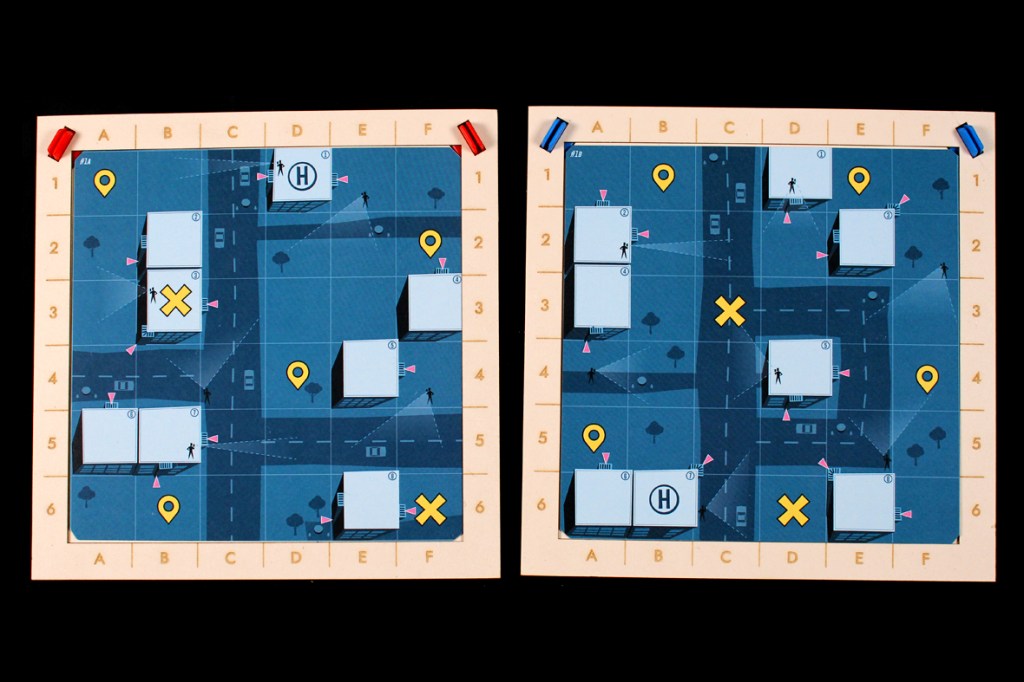
Choose a map, placing it in the tray so that the map number is in square A1. Then, attach the player screen to each player’s map tray:
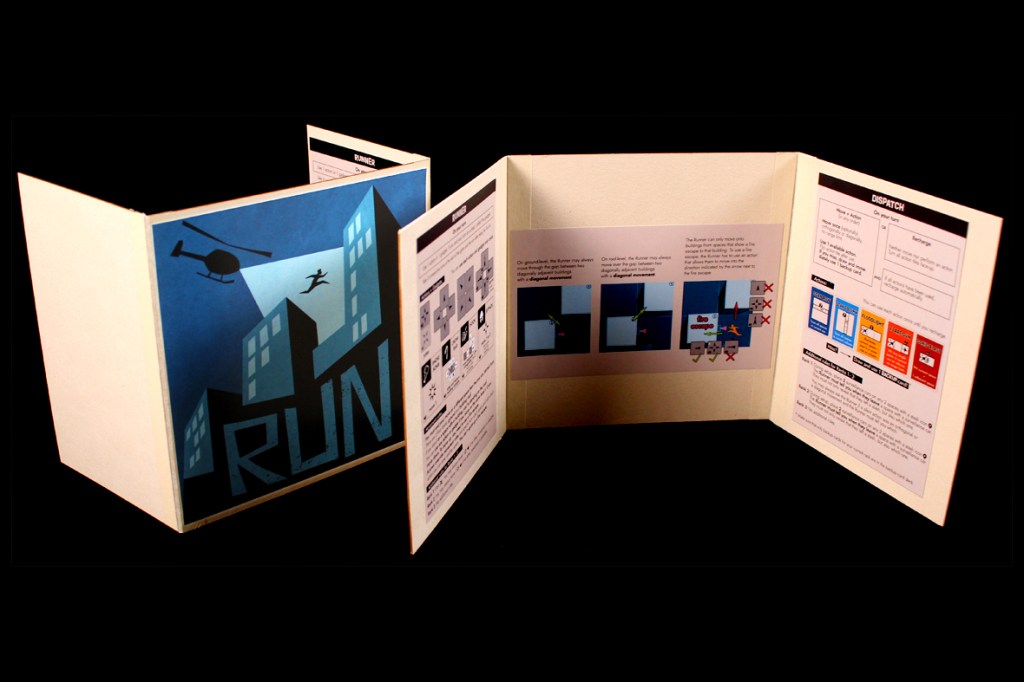
Set the evidence board between both players, facing the Dispatcher. Place the dry erase marker next to it, as well:
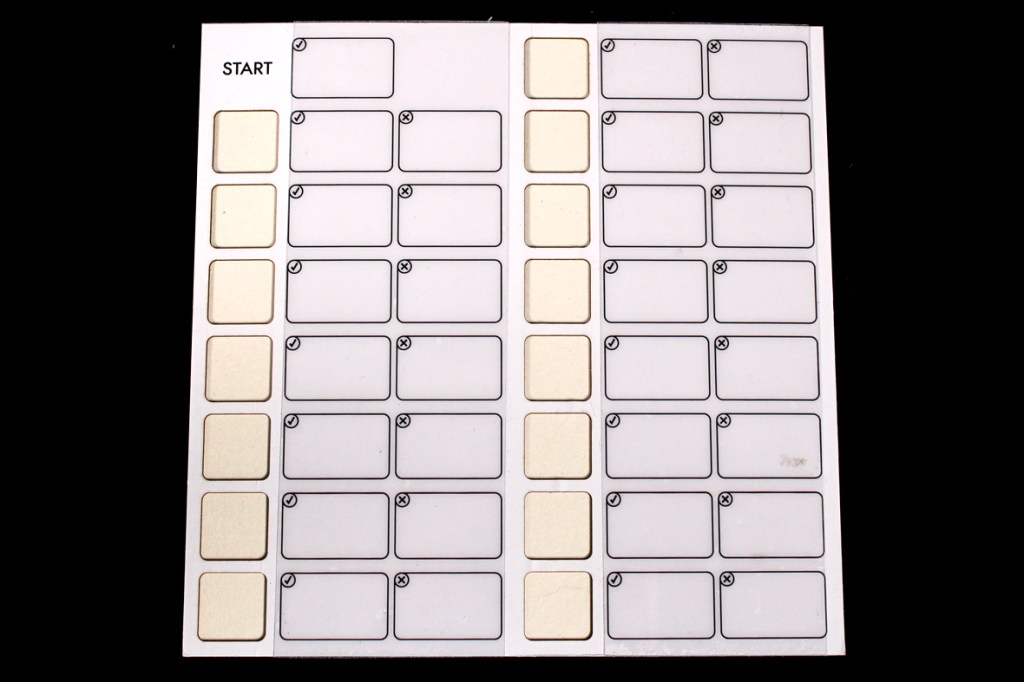
Then, take the Rank Cards for both roles, giving the Dispatcher their Rank Cards and the Runner theirs. Each player plays at Rank 1 for their first game. The Rank Cards may add additional setup rules or gameplay rules.
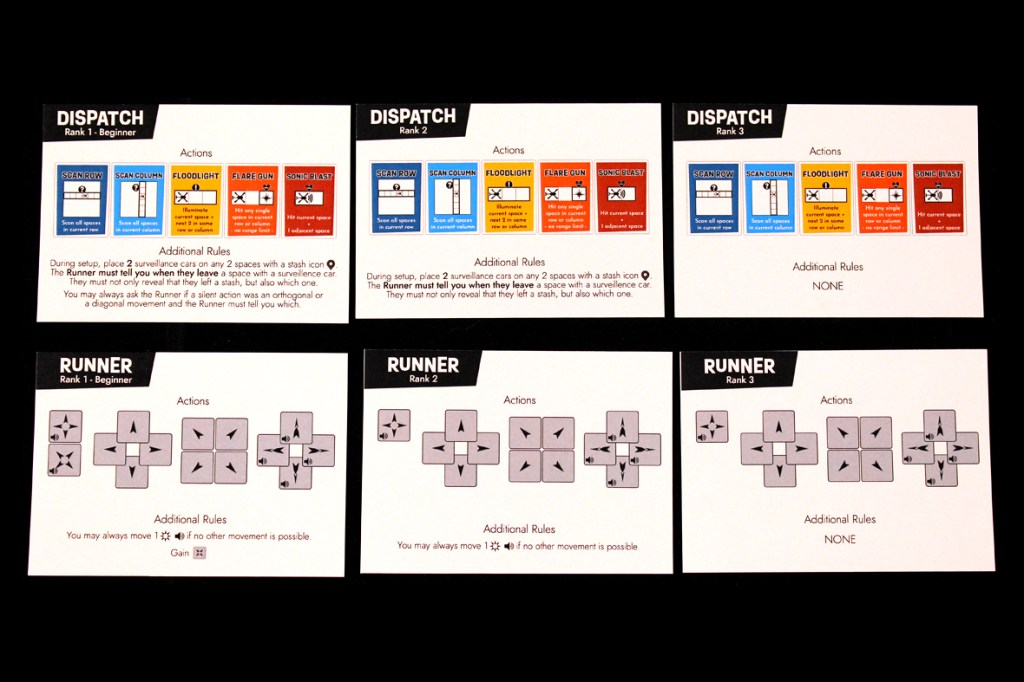
Now, set up the Dispatcher’s side. First, the Helicopter token goes onto the Helipad (and the other tokens go near the board):
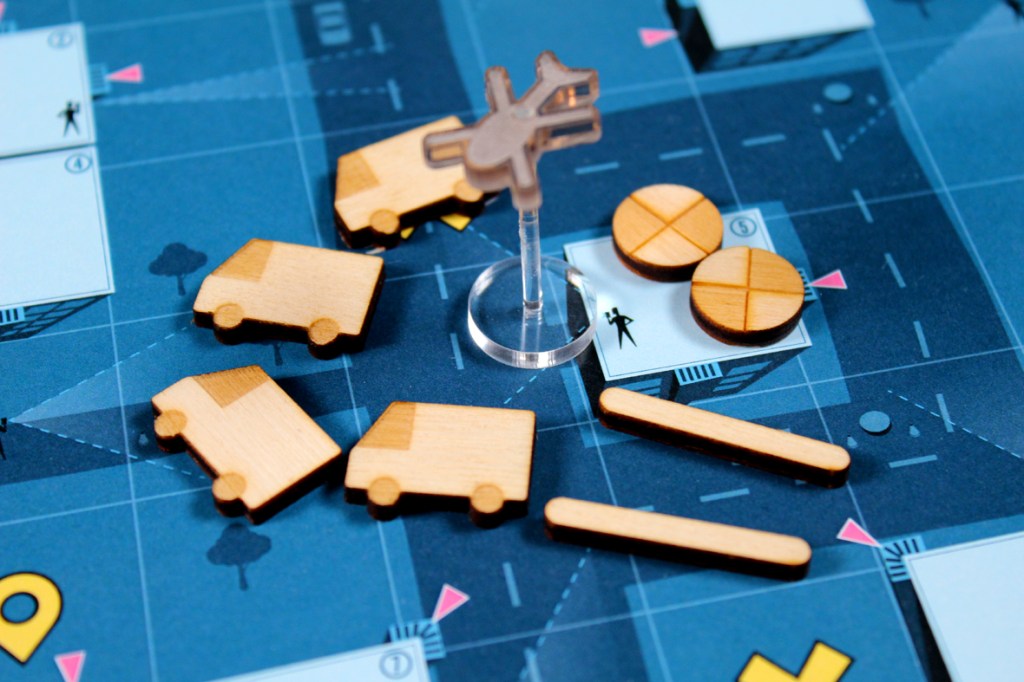
Next, the five action tiles are placed below the Dispatcher’s map:
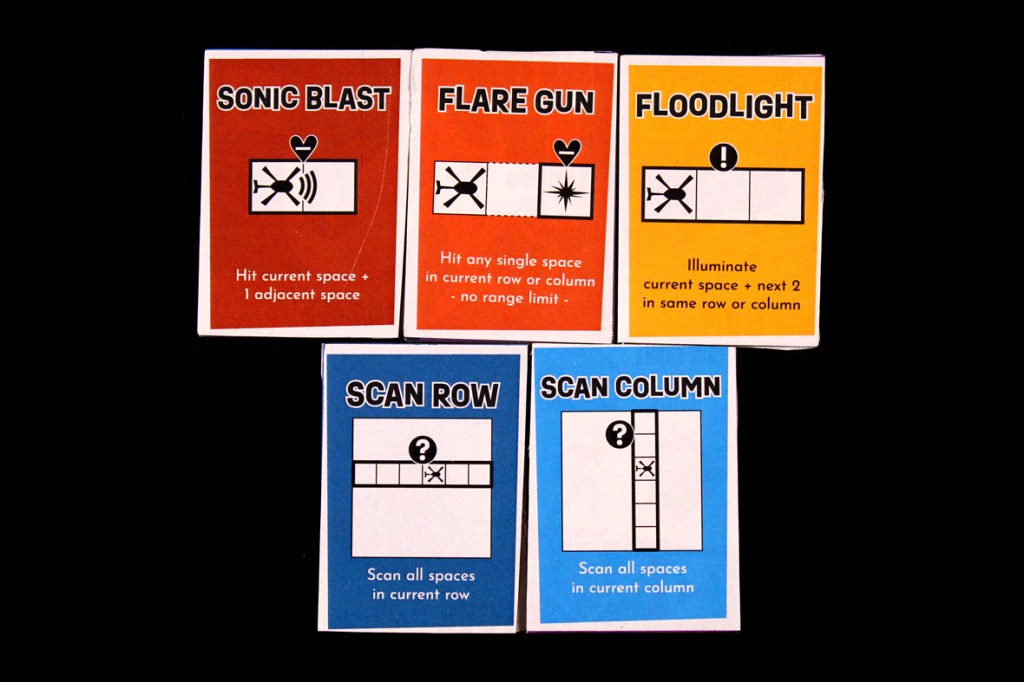
Place the tracking discs nearby:
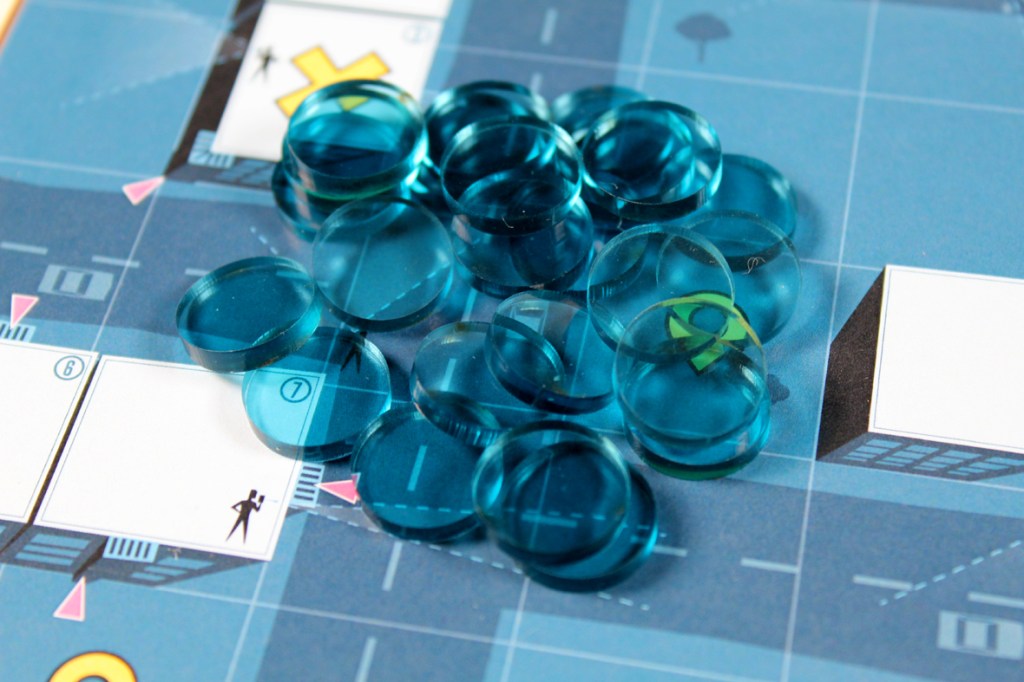
Finally, take the Backup Cards that correspond to the Dispatcher’s current rank and shuffle them. The other Backup Cards aren’t used.
The Runner is a bit easier to set up. Take their Action Board and place all the Action Tokens on it, except for the Diagonal Joker.
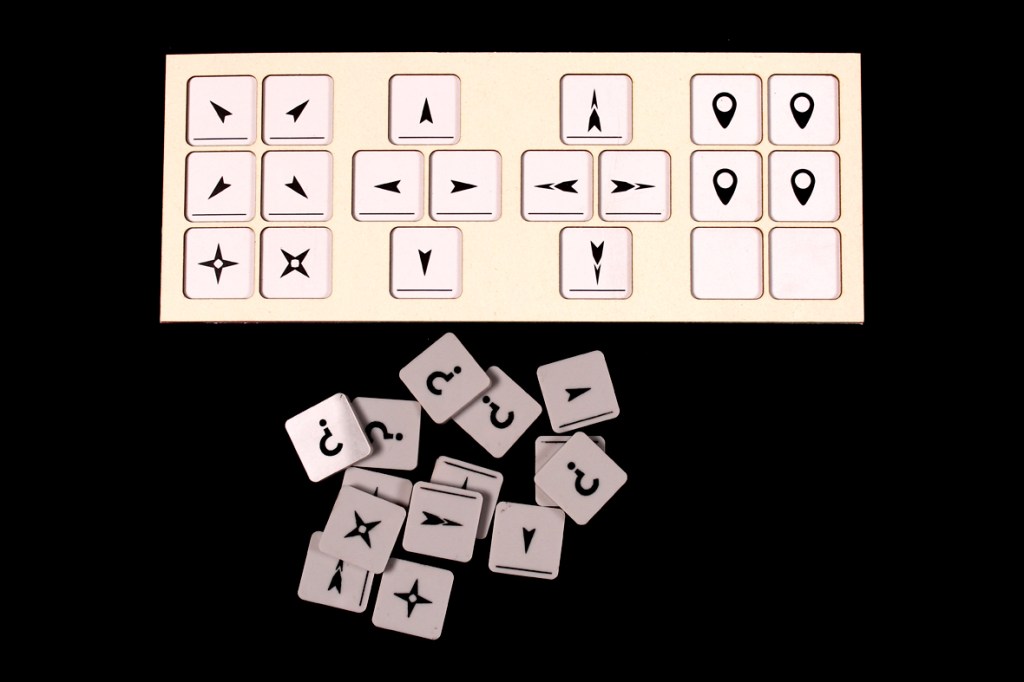
Then, place the Status Tile on the “Start” side next to the Runner’s Map Tray:
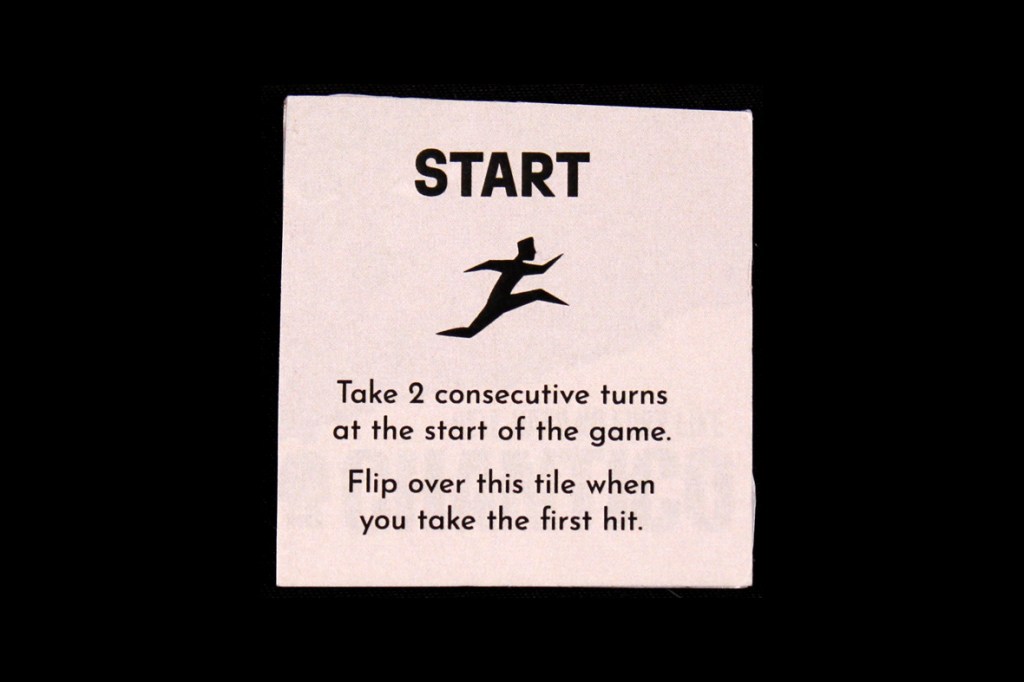
Shuffle the four Gadget Tokens, placing them face-down (stash side up) on each of the four Stash spaces on their Map.
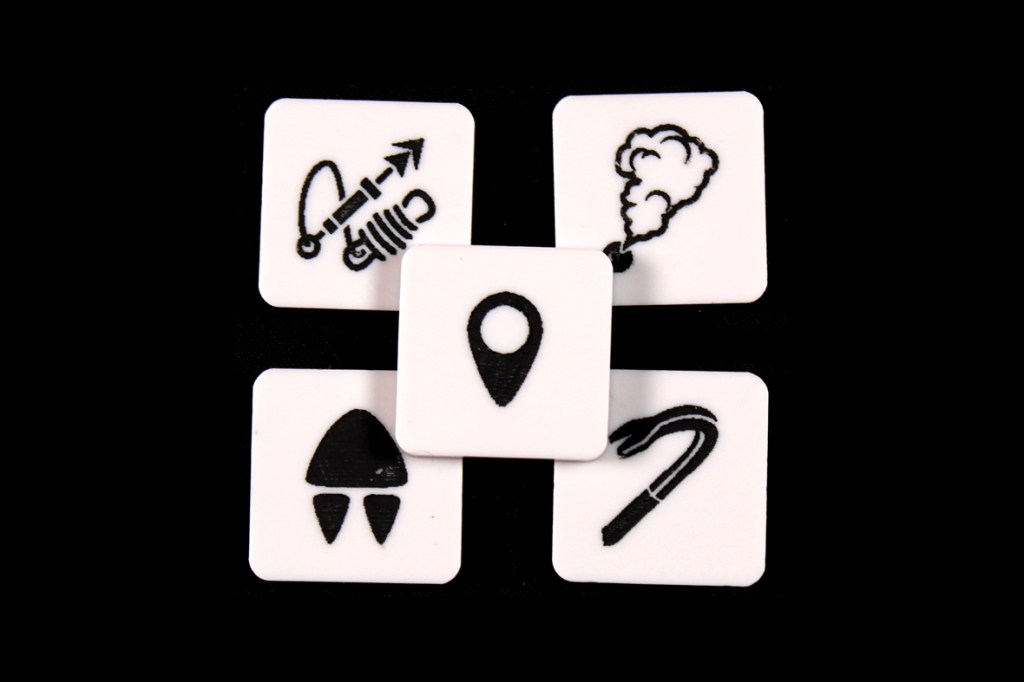
Finally, determine the Runner’s starting position by rolling an eight-sided die, placing them on the corresponding-numbered space. The Dispatcher does get to know the Runner’s starting location.
You should be ready to start!
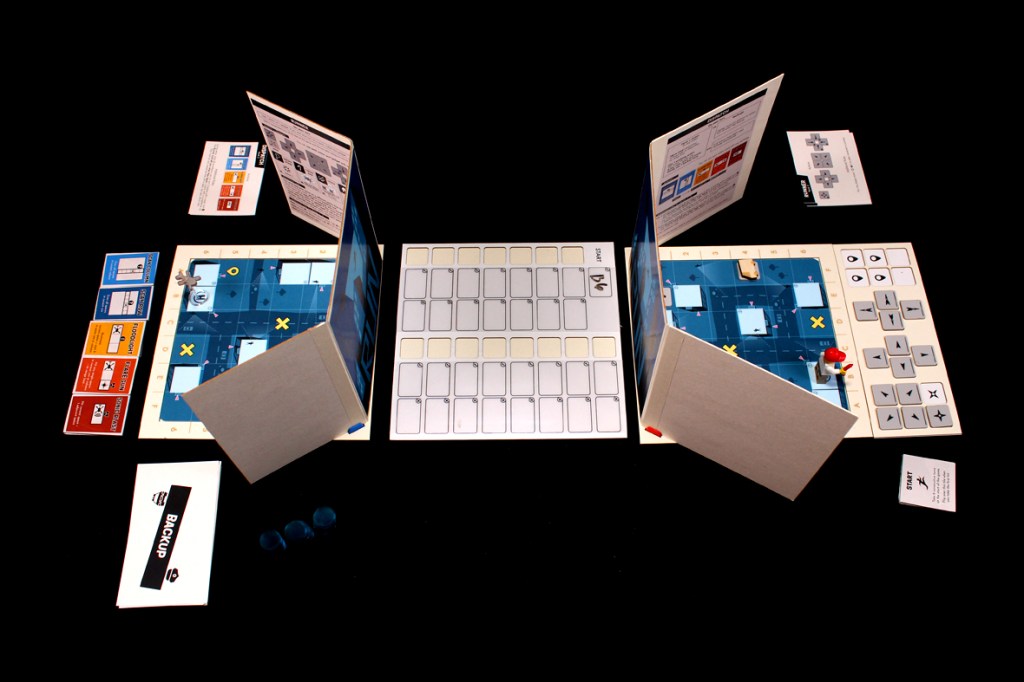
Gameplay
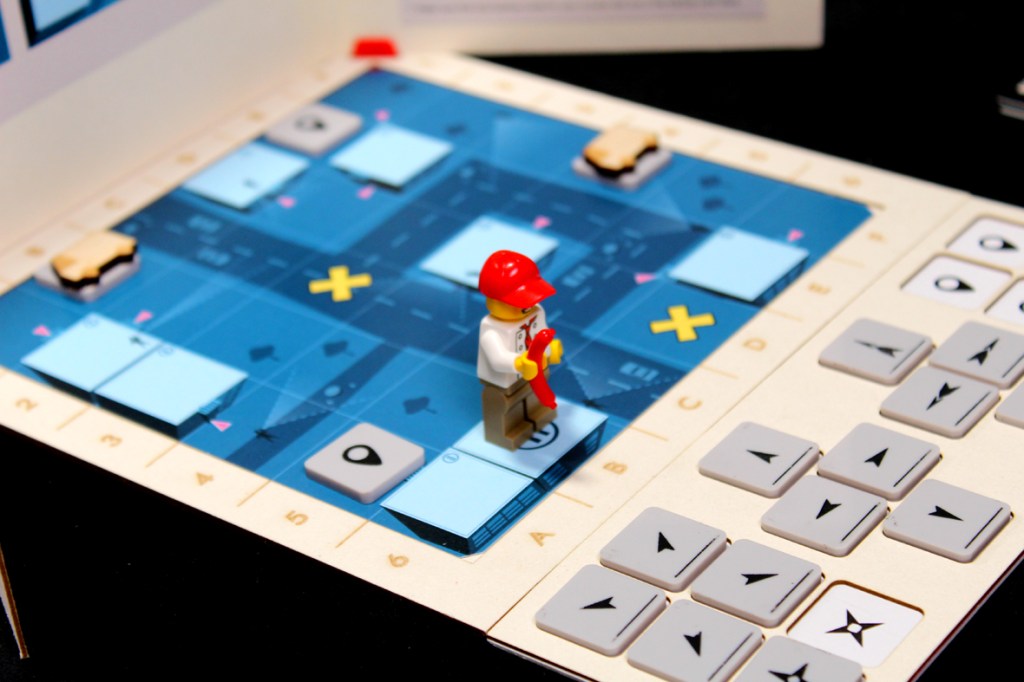
A game of Run takes place over a series of player turns, continuing until either the Runner or the Dispatch win. The game starts with the Runner, though they’ll take two turns to kick things off. Should they ever take a hit from the Dispatch, they’ll take two turns then, too. Let’s look at the Runner and Dispatch turns to learn more.
Runner’s Turn
First up is the Runner! Their goal is to move around the board and stay out of sight of the Dispatch’s various weapons and surveillance techniques. As they do, they will seek out their hidden stashes, get cool gadgets, and ultimately make a daring escape via one of their safe houses.
To start, the Runner must either take an Action or use a Gadget. Since they don’t start with any Gadgets, they’ll likely be taking an Action for a while.
When taking an action, the Runner removes the Action from their board, flips it over, and places it in the first available slot in the Dispatch’s Evidence Board. Many actions are double-sided, but some have a “?” on the back, indicating that they are Silent Actions. When the Runner takes a Silent Action, Dispatch knows that the Runner took one, but not which! Some Loud Actions are Sprints, which allow the Runner to move one or more spaces in the indicated direction. They do not tell Dispatch how many spaces they’ve moved. Similarly, Jokers tell Dispatch that the Runner moved one space orthogonally or diagonally, but not which. The Runner figure tracks their location on their board.
At Rank 3 or higher, if the Runner has no actions left on their Action Board, they lose! At lower ranks, they may still move one space in any direction when they run out of actions, but they must tell Dispatch what direction they moved in. Not great.
There are also a few Movement Rules worth mentioning. Some are the classics: the Runner must move into a different space than the one you started in, they can’t move off the map; things like that. Others are more complicated:
- The Runner can hop down from Buildings. They’ve got very springy ankles / knees. They can even start a Sprint on top of a a Building and continue it!
- The Runner must use a Fire Escape to get on top of a Building. Realism strikes again! The Runner cannot enter buildings, so they have to approach the fire escape from the indicated direction to get on top of the building. Once on top of a Building, they can move onto adjacent (even diagonally-adjacent) buildings.
- The Runner cannot Sprint up a Fire Escape. Honestly, that just sounds difficult. I’d be winded.
- The Runner can move diagonally through the gap between two diagonally-adjacent Buildings. The Buildings must be diagonally-adjacent, leaving that diagonal gap. The Runner can then move diagonally through that gap. This is the thing I forget the most.
Once the Runner ends their turn on a space with a Stash token, they take it and flip it, adding it to one of the Stash spaces on their Action Board. That becomes a Gadget that they can use on subsequent turns. Look forward to that.
Their goal is to get to three Stashes and get back to a Safe House (one of the big Xs).
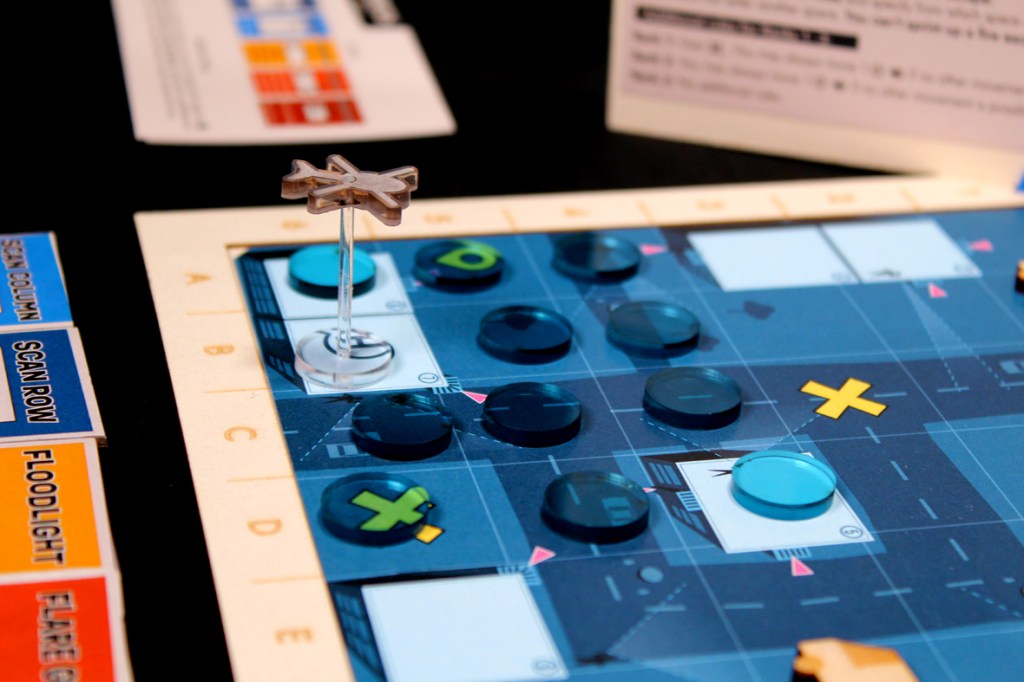
Dispatch’s Turn
On the Dispatch’s turn, they get two options. They can move and take an action, or they can alternatively recharge their actions.
To move, the Dispatch may move their Helicopter any number of spaces diagonally, or any number of spaces in their current row or column. Any number can include 0! Moving is not mandatory.
After moving, Dispatch must take one of their available actions. They have five, but each time they use one, it flips over until it’s reactivated. Most of these actions help Dispatch locate the Runner, but the Flare Gun and Sonic Blast can hit the Runner, which is how Dispatch wins the game.
When Dispatch uses an action, the runner confirms if they are in the indication location(s). If not, the Dispatch player misses. This allows them to draw a Backup Card, which gives them a choice of abilities, based on how many Gadgets the Runner has activated (and how many Backup Cards have been used). These abilities can help locate the Runner, move Dispatch, or make it harder for the Runner to slip around unnoticed.
In lieu of moving and taking an action, the Dispatch player may recharge their actions, flipping them all face-up. At the end of Dispatch’s turn, if all five action tiles are face-down, the Dispatch player may recharge them for free, instead of spending a turn to do it.
Their goal is to Hit the Runner two times.
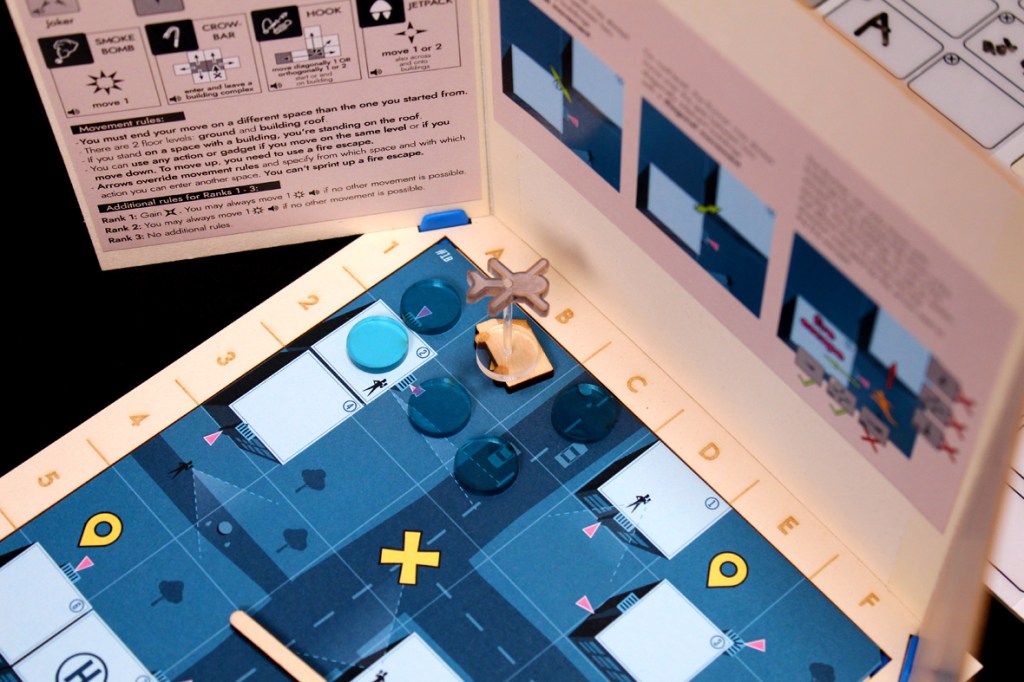
End of Game
As soon as the Runner has made it to a Safe House with at least three different Stashes hit, they win! As soon as the Dispatch gets a second hit on the Runner, Dispatch wins! Play until one of those things happen.
It’s possible for a Rank 3 (or higher) Runner to run out of Action Tokens during play. If that happens, they lose, and Dispatch wins!
Either way, as soon as a player wins, add their name to the Scoreboard and fill in one of the circles next to their current rank in the role they were playing. If that causes them to advance one rank, they’ll maintain that rank for subsequent games.
Player Count Differences
None! This one’s a two-player only game. I review a lot of these, I think. Two is just an easy player count to hit.
Strategy
- [Dispatch] You can, if you want, attempt to psych out the Runner by writing on your Evidence Board where you think they are, but it becomes a lot less impressive if you’re wrong. I mean, it’s quite the flex if you’re just writing down the Runner’s location, correctly, every turn. It psychs them out, to some degree! It may get the Runner to try and behave erratically. If you try this and you’re wrong, though, it just … makes you look like a bit of a clown. Try to avoid doing that.
- [Dispatch] Use the tracking discs! You can basically place them on every spot you think the Runner is on, and use that to find commonalities or most likely locations. I use these to try and essentially create loci of possibility. The more tracking disks on a location, the more likely I think that the Runner is currently there (or the more possible pathways that lead to that location). That lets you track movement across multiple turns, especially if you’ve already got some point that you know the Runner was at previously.
- [Dispatch] Try to avoid running out of ways to hit the Runner; if you do, you risk not having the ability to take them down when you actually do find them. I made this mistake, figured out exactly where the Runner was, and then had to waste a turn refreshing my action tiles so that I could actually go hit them. It may be worth trying to keep one active at all times so that you can always hit the Runner, should you successfully track them down.
- [Dispatch] Your movement is limited, to some degree. Try to set yourself up so that you can go where you need to go. You can only move in straight lines, so there are a few places that the Runner can be, relative to you, that you might not be able to hit or go to. You need to stay around where you think the Runner is so that they can’t get away from you.
- [Runner] A nontrivial amount of your effort should go into trying to confuse Dispatch. If they don’t know where you are, they can’t hit you. I try to make sure that I start with some kind of Joker + Sprint combo, so that there are a lot of places that I could possibly be. It’s even better if you can potentially avoid going after a Stash on your first turn, so that way the Dispatch has no idea where you are. That said, if you do hit a Stash in the first two turns, you can hold on to a Gadget for a while without using it, so that once you do use it, the Dispatcher might ultimately think you went to a different Stash than the one you hit.
- [Runner] Keep in mind that you can’t goof off forever. You can’t even really goof off in the same way twice. There are a surprisingly limited number of moves available! You need to move quickly to hit the Stashes, but once you’ve made a move in one direction, you can’t necessarily make that same move again later. That can throw a wrench in your gears if you’re not careful. You don’t want to end up needing a southwest move and not being able to have them.
- [Runner] Try to avoid being “tricky” when there’s only one place you could (or are likely to) go. It’s the same energy as Dispatch trying to guess where the Runner is and being wrong. If you use a joker and there’s only one direction you can really head, it can kind of be a waste of that move. That said, if you need that movement and you’ve previously spent the tile for that move, you can use a joker to make that move, which can help.
- [Runner] The Gadgets can help you be particularly tricky; use that to your advantage. Gadgets are a great way to obfuscate your movement, since there are a lot of potential places you can end up. Just keep in mind that using Gadgets gives Dispatch access to better Backup Card actions, so you need to make sure you’re getting the most out of them. They’ve got a lot of different and useful abilities, though, so they’re worth getting and using beyond just the necessity of having them in order to win the game.
Pros, Mehs, and Cons
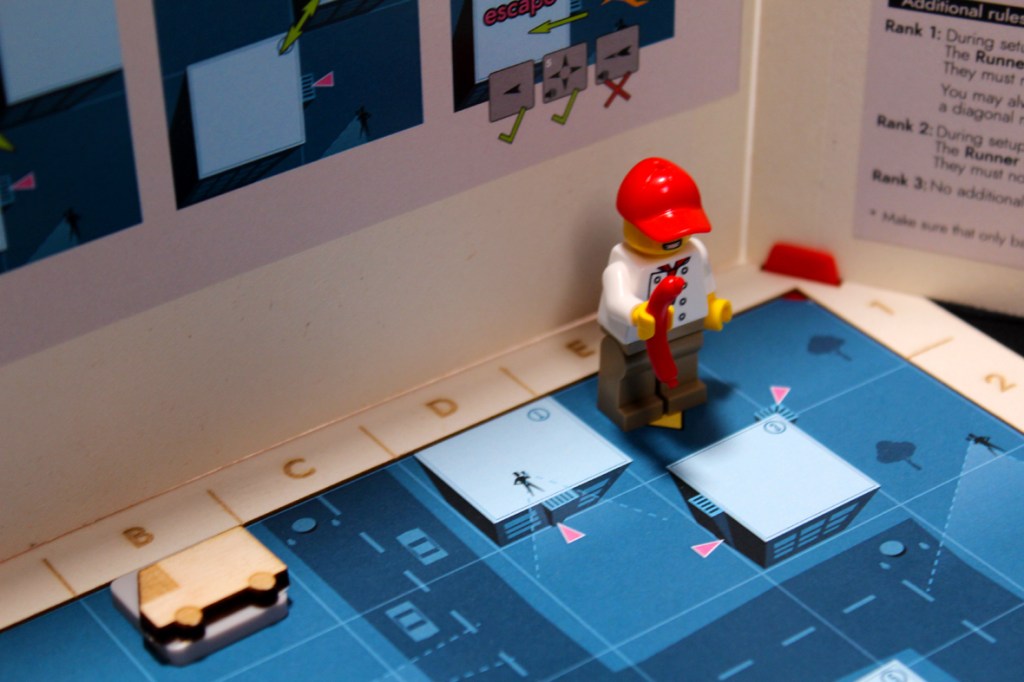
Pros
- I do love the theme. The cat-and-mouse chase is always fun, and it’s just a classic theme in a lot of different forms of media. I mean, Fugitive has also done this, granted, though I think Run! and Getaway Driver handle this very differently than the other games of a similar style. This has a lot more of a spatial element to it, and the asymmetry adds a lot. It’s also constrained, in contrast to Getaway Driver, which was hilariously expansive.
- The art scheme is also really nice! I like the dark color scheme quite a bit. It looks nice, it’s clean, and the whole thing is pretty fresh.
- I actually like that the player screens clip into the map board, a lot? It’s a very nice touch. I always have a bit of trouble with player screens in games; they’re liable to fall over, they end up feeling flimsy, and I can’t get them to sit where I want. Having clips in the map board for them so that they always stay in the right spot is ideal, and I’m kind of amused that I haven’t seen it before.
- Once you get a good sense of the game, it plays quickly. That may take a bit depending on how quickly you pick up asymmetry and how good your spatial deduction is, but it can happen.
- I also like that you can, after playing, switch roles. It’s very much a game where you can stand up, swap seats, and go back for another round. That also works well with the rank system, so that players can go head-to-head as they gradually improve, switching roles to compensate every few games.
- While as a reviewer, a ranking system can be a bit of a pain, as a player, I think it’s a really nice way to introduce players to a game while still giving them a shot at winning, no matter who they play as. I’d love to say that I’ve tried the game at every rank and every possible rank combination, but I am a finite being. As a player, though, this is a really nice way to track your performance in a game and make sure that players are accounting for skill and experience when they play each other. It nicely compensates for the advantage an experienced player would have.
- I’ll be interested to see how the other Maps / Gadgets turn out. I like that more maps are potentially going to happen, and that more Gadgets might, as well. The configurability could make this pretty exciting.
- Oh, the best thing. The spaces are just big enough that a LEGO minifigure fits on them perfectly, so you can get up to all kinds of shenanigans if you’ve got the right one. We had a blast with a few LEGO minifigs. I went on a crime spree as John Hotdogmanson (a LEGO man holding a hot dog), and successfully got away with it. I wonder if this means we have any shot at getting a Burgle Bros. LEGO set? Maybe someday.
- I also like the Silent Actions and Backup Cards, mechanically. I think the asymmetry adds a lot to the game, and I like how these two features in particular give the Runner something that the Dispatch can’t necessarily figure out straight away, and the Dispatch something that gets stronger as the Runner gets closer to winning. They both do a good job of giving each character a pretty useful arsenal of skills.
- They figured out how to nail the feeling of suspense, I think. I pretty much always felt like Dispatch was right on top of me, and the Runner felt the same way when I was playing Dispatch, which was exciting. In other games, it’s usually more about keeping them totally lost; here, they’re always within a few spaces of you, looming. It’s thrilling.
Mehs
- Since you need to get two hits on the Runner, and they get two consecutive turns after the first hit, there is a practical point where Dispatch has lost and might not know it. It’s not the worst thing, it just seems like there should be a “Runner Win” preemptive victory condition rather than dragging it out for no reason. The situation is, effectively, if the Runner has not been hit and is two moves away from winning, even if the Dispatch hits them next turn, they get two consecutive turns after that and therefore win by default (barring an aggressive misplay).
- Shooting a criminal with a flare gun feels like a war crime. I thought it was, and in an attempt to find out, I have now Googled enough things about flare guns and the Geneva Convention and the UN Convention on Conventional Weapons that I’m definitely on some list. Whoops. I think it’s highly likely the Dispatch is just illuminating the Runner’s exact location (like losing Stealth in Burgle Bros., but the implication around the word “Hit” is a bit amusing, in a macabre way.
Cons
- I foresee myself always forgetting that you can sprint diagonally between buildings, and a few other rule minutiae. I think there’s probably a way to mark that diagonal movement between buildings and in the space between buildings is possible, but I’m not really a graphic designer to any degree. It’s just easy to forget.
Overall: 8 / 10
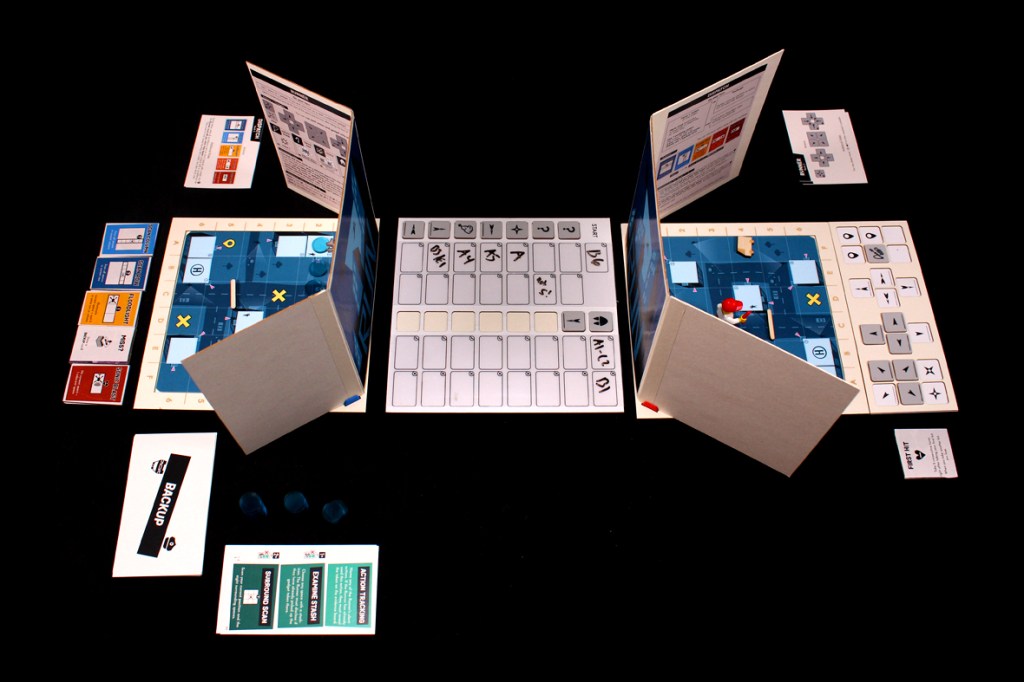
Overall, I think Run is quite fun! I think Fowers Games as a publisher has been trying to focus more on games that are a bit exciting and flashy, and Run fits quite well in that portfolio. What this does particularly well is channeling the feeling of suspense in with the thrill of the chase, as the Dispatch always feels close to the Runner, both as a feeling of power for Dispatch and as a very real threat for the Runner. That excitement keeps the game interesting, and certain quality of life measures taken keeps the game fun. For one, I really like the idea of rank as a way to preserve some state between games and let players find a skill balance that works for them. It means that a very experienced player will ultimately have tougher limitations, balancing the game out so that a less experienced player has a legitimate shot at winning. For the more experienced player, the challenge is the reward. Are they good enough that they can compensate for it? Very exciting. Add in a fun art scheme, some entertaining deduction, and a jetpack or two and you’ve got a pretty good time. Since it’s a preview copy, I’m very excited to see how the full version turns out, but I was impressed with what I got to play of it. Run’s the kind of game you can play, lose, and then swap seats and play again to see if you can do any better than the other player, and I enjoy that sort of thing. Great game for two folks who want a really intense head-to-head experience that won’t exhaust you from playing. If you’re looking for that sort of thing, you enjoy Fowers Games’s style of titles, or you just want to have a bit of deduction and suspense in your next game night, I’d recommend Run! I had a lot of fun playing it.
If you enjoyed this review and would like to support What’s Eric Playing? in the future, please check out my Patreon. Thanks for reading!
